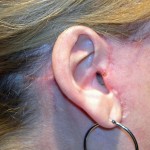
A facelift is not what most people think it is so its recovery is much better and quicker than one might think. Facelifts are neck and jowl procedures so they do not affect anything north of the jaw line. So swelling and bruising is limited to the side of the face and the neck. Now many people do other procedures with a facelift (most typically the eyes) which causes swelling and bruising there but this is not the result of the facelift. An isolated facelift affects the neck primarily.
Even with some swelling and bruising of the neck, it will look better in contour and shape than it did prior to surgery. So factor out swelling as a significant concern, it is the bruising which may be most apparent. I prefer to use drains for the first 24 hours in my full facelifts as this definitely helps decrease the amount of bruising that will occur. Most of the bruising that develops will end up very low in the neck. Over the first week or so, gravity will pull this bruising even into the upper chest area. This is common so do not be alarmed. Bruising can be easily covered up with makeup. Clearing of the faintest of facelift bruising in the neck may take up to two weeks after surgery.
Since a facelift obviously uses incisions, a big concern is what my incisions or scars will look like right after surgery. In the vast majority of patients, and providing there are no healing problems, these incisions will turn out to be of no concern for you. Because of the way they are placed (in, out, and around the ear) and the superb healing of facial incisions in general, they look remarkably good quite early. The attached photo to this blog shows facelift scars just three weeks out from surgery. While close inspection may reveal them, they are not apparent to the casual observer even this early after major facelift surgery.
The side of the face and entire neck will feel somewhat numb, stiff, and little ‘lumpy’ for the first few weeks. This is normal as the skin nerves have been disrupted (temporarily losing feeling particularly close to the ear) and the skin has not yet healed completely healed underneath it. Some areas of fluid and blood will make it feel irregular. This will go away naturally by the first month after surgery.
While the thought of facelift surgery is scary, it is much easier to go through one might imagine. There is very little pain (most of my facelift patients don’t take pain medications after the first day or two) and the swelling and bruising is not that significant. The incisions around the ears are barely noticeable. When it comes to going out or returning to work, I tell my patient in my Indianapolis plastic surgery practice that 10 to 14 days should be more than sufficient for full facelifts. For more limited facelifts (e.g., Lifestyle Lift), it is more like a week.
Dr. Barry Eppley
Indianapolis, Indiana


